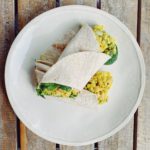Today’s McDaniel Short-Cut recipe, Curried Chickpea Wrap, includes my favorite short-cut of all: canned beans.

If I’ve got canned beans on hand, I can make a simple lunch or dinner in minutes:
- Canned black beans: Black bean tacos or southwestern salad with black beans, roasted corn & avocado
- Canned refried pinto beans: Huevos rancheros
- Canned white beans: White bean chicken chili
Immunity Starts With the Gut
With the coronavirus on everyone’s mind, we’re all doing what we can to support a healthy immune system. Beans, can help us do that. I’ll explain how in a minute. 70-80% of our immune cells are located in our gut. The bacteria in our gut are responsible for immune cell programming. Therefore, the better populated + diversity of bacteria, the better our immune system. In addition, our good bacteria form protective barriers in our intestines to protect us from harmful microbes.
How To Feed Your Flora
Outside of adequate sleep, hand-washing and staying away from crowds, we can support our immune system by eating gut-healthy foods. You don’t need to be a vegan or vegetarian, but you do need to eat a wide variety of plant-based fibers. Good bacteria thrive off of plant-based foods like fruits, vegetables, beans, nuts and seeds and fermented foods.
Resistant Starches: A Gourmet Meal for Gut Bugs
Resistant starches are a specific type of plant-based fiber that resist being broken down like other carbohydrates; instead, they are fermented in the large intestine and act as a “prebiotic.” You’ve likely heard of probiotics. Think of “prebiotics” as the food for probiotics.
Benefits of Resistant Starches
- Improved gut health. Probiotics found in foods like yogurt, kefir milk or kombucha contain live bacteria to support gut health. But, they need food like fiber to thrive! Prebiotics, such as resistant starches, are preferred fuel for good bacteria.
- Blood sugar control. Since resistant starches are not broken down for energy, they do not raise blood sugar levels. This can improve insulin sensitivity over time.
- Increased satiety. Resistant starch is considered a type of fiber, and therefore it helps to keep you full longer. Increased satiety leads to higher levels of weight loss.
- Lowers risk for colon cancer
Sources of Resistant Starches (Lots in our Curried Chickpeas!)
- Plantains and green bananas (as a banana ripens the starch changes to a regular starch)
- Beans, peas, and lentils (white beans and lentils are the highest in resistant starch)
- Whole grains including oats, farro and quinoa
- Cooked and cooled rice
Curried Chickpea Wrap
Our curried chickpea wrap, when wrapped with a whole-grain tortilla, is choked full with plant-based fiber and protein. We’ve also included some anti-inflammatory herb and spices such as turmeric, curry, and garlic to give this wrap a Mediterranean feel. We pray you stay well, safe and sane through these challenging times.
Check out last week’s McDaniel’s Short-Cuts: Tofu Stir-Fry with Peanut Basil Sauce

Curried Chickpea Wraps
- Prep Time: 10
- Cook Time: 10
- Total Time: 20 minutes
- Yield: 6-8 1x
Ingredients
Chickpea Mixture
- 2, 15.5 oz. canned chickpeas, rinsed and drained
- 4 T. mayonnaise (we used olive oil mayo)
- 2 T. plain Greek yogurt
- 1 T. dijon mustard
- 1 t. honey
- 1 t. garlic powder
- 1 t. curry powder
- 1/2 t. turmeric
- 1/4 t. salt
- 1/2 c. chopped red onion
- 1 c. chopped cilantro
Wrap
- 6–8 whole-wheat tortillas
- 2 c. greens (arugula, kale or spinach would taste great)
Instructions
- In a mixing bowl, mash chickpeas with mayo, yogurt, mustard, honey and spices. You can use the back of a large form, whisk or potato masher. It will take a good 5-8 minutes, expect a workout.
- Once mixture is to your desired consistency (I liked 3/4 mashed and 1/4 whole chickpeas), fold in onion and cilantro.
- Build your wrap with chickpea mixture and greens (spinach, kale or arugula).
Nutrition
- Serving Size:
- Calories: 238
- Sugar: 1.3 g
- Sodium: 567.7 mg
- Fat: 13.2 g
- Saturated Fat: 1.8 g
- Carbohydrates: 25.1 g
- Fiber: 8.9 g
- Protein: 9 g
- Cholesterol: 0.8 mg

